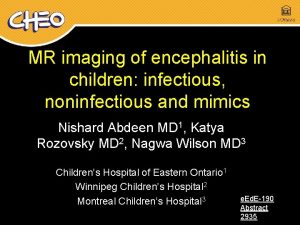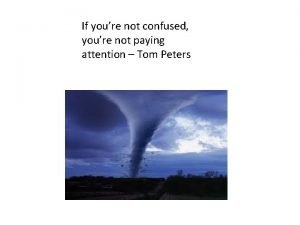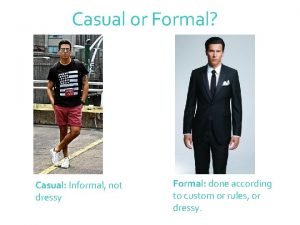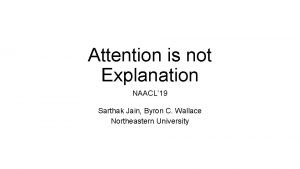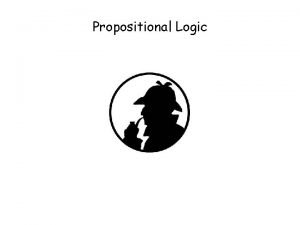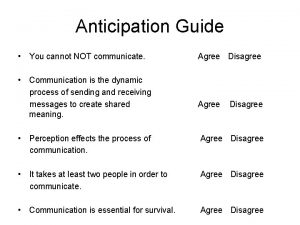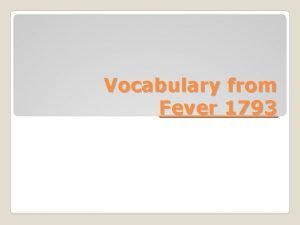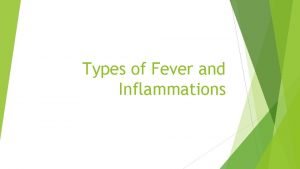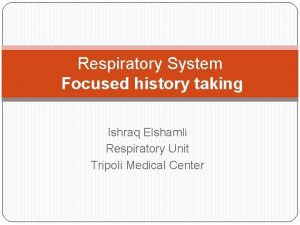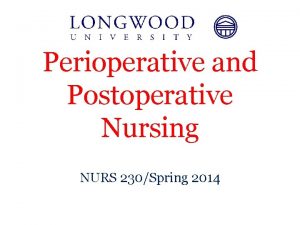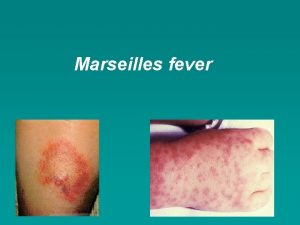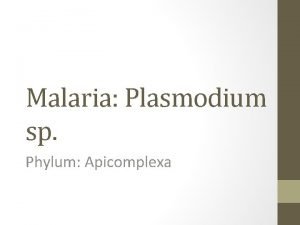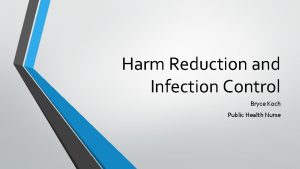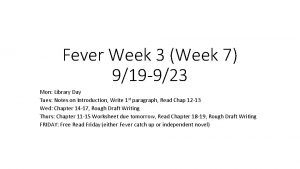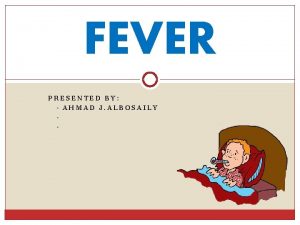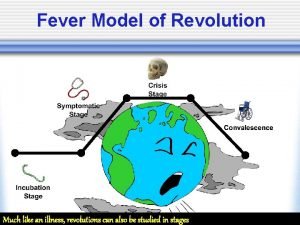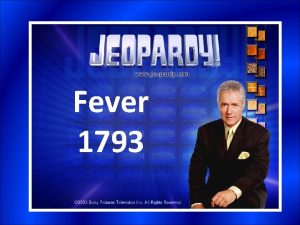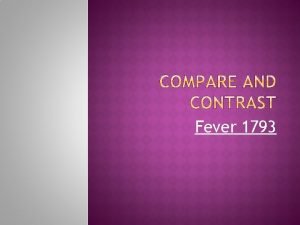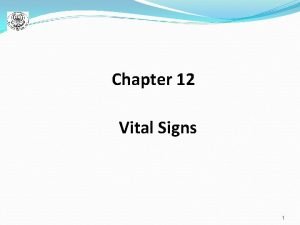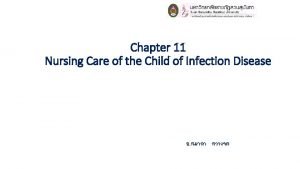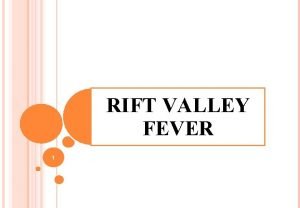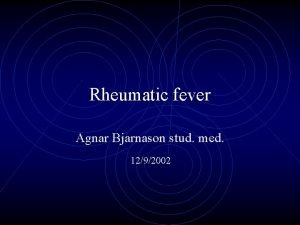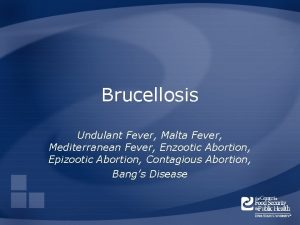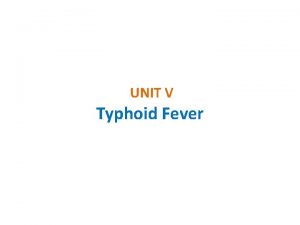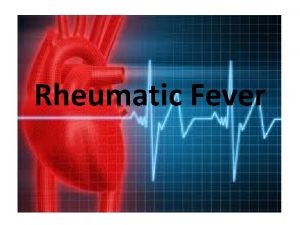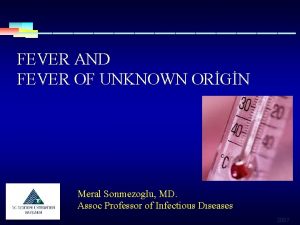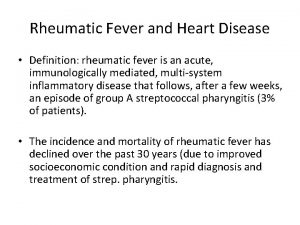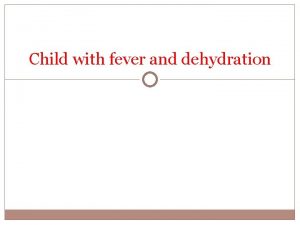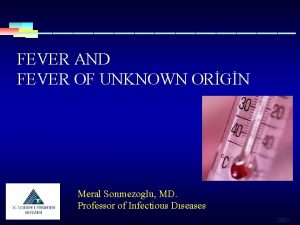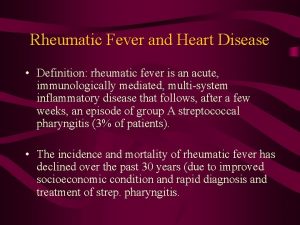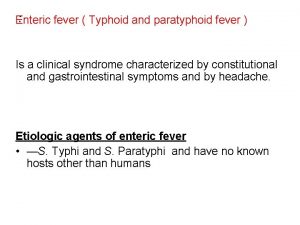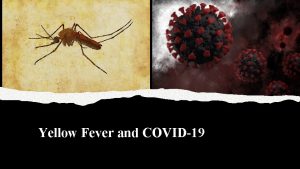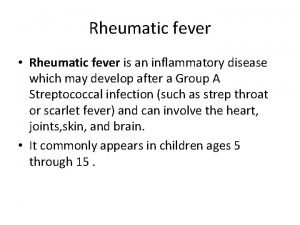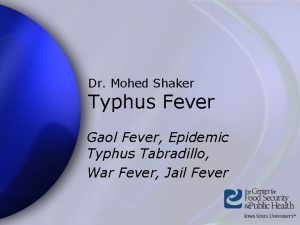When is a fever not a fever and




















































- Slides: 52

When is a fever not a fever and other diagnostic riddles in the DD/ID population Sharon Oxx RN, CDDN Director of Health Services, Massachusetts Department of Developmental Services

Yale Study (2000) on “Health Status of Individuals with Mental Retardation” Findings: Barriers to Care Uncoordinated systems of health care Ø Individual may be unable to understand how behavior affects health Ø Health care provider’s (HCP) lack of training in caring for people with mental retardation Ø Direct support professionals (DSP) lack training to recognize health issues Ø

Yale Findings: Barriers to Care (cont. ) Ø Poorly documented health history Ø No standardized health care guidelines for individuals with ID Ø Few programs to educate individuals with ID on disease prevention Ø Ineffective communication with health care provider

Surgeon General’s Conference (2001): Health Care Disparities for Individuals with MR Work Group Issues Attitudes of health care professionals Ø Quality of health services Ø Accessing health services Ø Paying for health services Ø Age-appropriate health services Ø Health services throughout the lifespan Ø Promoting health: providers Ø Promoting health: individuals and caretakers Ø

DDS Organizational Structure Ø Commissioner – authority delegated through Assistant Ø Four Regional Directors – authority delegated to Commissioner for Operations to Regional Directors Area Directors • • Central/West Region – 8 Areas Northeast Region – 5 Areas Southeast Region – 7 Areas Metro Region – 4 Areas * Always an administrator on call at Area office Ø At least one DDS RN available in each Area office

Selected Service Delivery Principles Ø Provision of services and supports that are intensive, relevant and competence building/sustaining Ø Services and supports promote individual dignity and self determination Ø Services and supports in least restrictive most typical settings possible Ø Services and supports in integrated settings in the community Ø Use of generic services whenever possible

Why would someone with a behavioral change be brought to the ER rather than a psychiatric facility? Because a change in behavior is often the first sign that a person has a serious medical condition.

Significance of Behavior Issues Ø Problem is common in I/DD population Ø Often difficult to understand cause of behaviors Ø Necessary to learn correct approach for persons demonstrating inappropriate behavior

Significance of Behavior Issues (cont. ) Ø Quality of life concerns Ø Family or relationship issue Ø Maintaining safe living and working environment for individual and staff or family

Possible Reasons for Behaviors Ø Medical disorders Ø Medication side effects Ø Psychiatric conditions Ø Substance abuse Ø Social or environmental issues Ø Communication difficulties Ø Physical or emotional abuse

Examining Behavioral Symptoms Ø R/O medical cause Ø R/O environmental or functional cause Ø R/O psychiatric cause

Interviewing the Individual Ø Be positive and respectful Ø Discuss issues openly Ø Validate the person’s feelings Ø Address the person directly Ø Avoid criticism and accusations Ø Reduce anxiety/ environmental stimulus Ø Do not rush

Individual’s Medical History Ø Current and past medical problems Ø Current and past medications Ø Natal history Ø Vital signs Ø How they communicate health problems Ø Past injuries Ø Surgical interventions

Defining and Analyzing the Problem Behavior Ø How long has behavior been an issue? Ø Where does the behavior happen? Ø When does the behavior occur? Ø Are there any triggers to behavior?

Defining and Analyzing the Behavior (cont. ) Ø How much time does the individual spend demonstrating behavior? Ø Is the behavior cyclic? Ø Does the person engage in behavior when alone or only when with others? Ø How does person behave after incident?

Defining and Analyzing the Behavior (cont. ) Ø What interventions have worked or not worked in the past? Ø Is there physical danger to the person or others? Ø Does it prevent meaningful activity Ø Does it effect quality of life? How?

Defining and Analyzing the Behavior (cont. ) Ø How frequent, long, and intense is the behavior? Ø Are there any concurrent physical complaints at the time of the incidents? Ø Are the physical complaints new or recurring?

Assessing for a Medical Condition: SIB Hand biting, chewing of fingers Hitting or banging head Dental pain, nausea, indigestion, reflux, local infection Headache, migraine, shunt problems, sinusitis, dental pain, ear or eye infection

Medical Conditions: Scratching or Rubbing General Stomach or Abdomen Eczema, other skin conditions, scabies, lice, insect bites, sunburn, liver or kidney disorder Ulcer, gastritis, gall bladder or pancreas problems, menstrual discomfort, cramps or constipation

Medical Conditions: Scratching and Rubbing (cont. ) Chest Pneumonia, indigestion, reflux, angina Rectum Constipation, hemorrhoids

Medical Conditions: Aggressive or Violent Behavior Ø Hypothyroidism Ø Hyperthyroidism Ø Temporal lobe seizures Ø Caffeine Ø Substance abuse Ø Headache Ø Infection

Medical Conditions: Unusual Postures or Movements Rocking Head Tilting or Waving Back or hip pain, indigestion, reflux, abdominal cramps Visual problems, sinus or ear infection

Medical Conditions: Movements or Postures (cont. ) Sitting, Sudden Sitting Vertigo, cardiac problems, seizures, aspiration, reflux Other Unusual Posture Limb fractures, hip pain, rectal pain, genital pain or itch, nerve damage, constipation

Medical Conditions: Recurrent Masturbation Ø Urinary tract infection Ø Vaginal infection Ø Prostate inflammation Ø Prostate hypertrophy

CASE #1 q WBC: 9. 2 q WBC: 2. 5 q Temp. : 98. 7 q Temp. : 96. 8 q BUN : 22 q BUN: 13 q Mental Status: Lethargic q Mental status: Alert q Lungs: Clear to auscultation q Chest X-ray: Clear

Functional Behavioral Analysis “Accurate identification of the situational and environmental factors that influence behavior is essential to the success of a positive behavioral approach. ”

Positive Behavioral Supports Ø Teach new skills Ø Change the environment to better suit the individual Ø Ignore non-dangerous behavior Ø Substitute constructive activity Ø Remove the individual from the situation

Functional Assessment Ø Is the behavior used to avoid or escape? Ø Is the behavior used to get attention? Ø Is the behavior used to obtain assistance? Ø Does the behavior communicate other needs or wants?

Functional Behavioral Analysis: Indirect Assessment Structured interviews to obtain information about the behavior Ø Settings in which behavior does and does not occur Ø Others present when behavior occurs Ø Activities or interactions prior to and immediately after behavior Ø The individual’s perceptions and feelings about their actions

Functional Analysis: Direct Observation Observing and recording situational factors Ø In natural settings and conditions Ø Must not interfere with normal routines and activities over extended periods of time Ø Multiple observations of the behavior whenever possible

Functional Analysis: Data Analysis Comparison and analysis of the collected information Ø Identify any patterns associated with the behavior Ø Determine the relationship between the behavior and environmental events Ø Identify more acceptable alternatives to the behavior

Functional Analysis: Hypothesis Statement A plausible explanation for the behavior based on the data Ø Predicts the conditions under which the behavior is most likely or least likely to occur Ø Predicts the likely consequences that motivate the person and maintain the behavior

Functional Analysis: Hypothesis Testing Confirms or disproves the hypothesis Ø Systematic changes implemented to control conditions and consequences Ø Confirms hypothesis or identifies need to formulate a new one

Functional Analysis: Behavior Intervention Plan Replace the behavior with positive or neutral alternatives that serve the same function Ø Increase existing desirable behaviors Ø Encourage development of additional desirable behaviors

Functional Analysis: Behavior Plan (cont. ) Ø Make the environmental or situational changes that reduce or eliminate the possibility of engaging in undesired behavior Ø Provide the supports necessary for the person to use alternative behaviors

Case # 2 Ø Crying Ø Affable Ø Abdomen distended Ø Quiet Ø Temp. 97. 2 Ø Temp. 97 Ø No BM x 5 day Ø Daily BM Ø WBC 6. 7 Ø No history of constipation Ø X-ray Abdomen: fecal impaction Ø Good appetite and fluid intake

Assessing for a Psychiatric Condition Indicators of a Psychiatric Condition Ø The behavior is consistent in all settings and situations. Ø A consistent behavioral intervention has had little or no effect on the behavior. Ø The individual does not appear to be able to start or stop the behavior at will.

Behavioral Symptoms of a Psychiatric Condition Changes in sleep pattern Excessive sleep, constant fatigue, little or no sleep, interrupted sleep Changes in appetite Lack of appetite, intensely fearful of food, inspects or refuses food

Psychiatric Conditions: Excessive Moods (cont. ) Happy Excessively elated over period of time, grandiose thoughts and ideas Sad Depressed mood over period of time that is not related to loss or grief, loss of interest in pleasurable activities, talks about death or hurting self, change in sleep pattern, change in appetite

Psychiatric Conditions: Excessive Moods Worry Anger Constant and excessive talk about particular daily events, repetitive behavior rituals to ensure or prevent an event Threatening or hostile to others, agitated or irritable, appears angry at strangers, anger that is excessive for the situation

Psychiatric Conditions: Hallucinations Auditory Hallucinations Stares to side or corners and appears to be involved in conversation, covers ears Visual Hallucinations Appears to be shadow boxing, covers eyes, brushes unseen material off body

Psychiatric Conditions: Appearance Clothing Wears multiple layers of clothing, unusual wrappings around head, uses wrappings to enclose openings such as collars, sleeves, ankles, etc.

Psychiatric Conditions: Appearance (cont. ) Cleanliness Refuses to bathe or shower, bathes or showers excessively Bruises/ Cuts Accidental or purposeful self-harm

Case # 3 Ø Fearful Ø Cooperative Ø Combative Ø Trusting if routine followed Ø Hallucinating Ø Ø Hx. of psychiatric dx. Living with same people for 10 years Ø Currently taking Mellaril 50 mg q HS Ø Has been stable psychiatrically for 10 years

Rank 1 Top 10 Leading Causes of Death U. S. 2003 MA 2003 Heart Disease 28. 0% 26. 0% DMR 2000 Heart Disease DMR 2001 DMR 2002 DMR 2003 DMR 2004 Heart Disease 21. 2% 22. 3% 18. 5% 2 Cancer 22. 7% Cancer 24. 1% Pneumonia Aspiration Pneumonia 12. 3% Cancer 13. 5% Cancer 12. 5% 3 Stroke 6. 4% Stroke 6. 0% Chronic Respiratory Disease Cancer 12. 7% Cancer & Septicemia[5] 10. 1% Aspiration Pneumonia 12. 3% Aspiration Pneumonia 11. 2% 4 Chronic Respiratory Disease 5. 2% Chronic Respiratory Disease 4. 9% Cancer Septicemia 7. 4% C-P Arrest/ Seizure 30 9. 4% Septicemia 9. 0% Influenza and Pneumonia 10. 9% 5 Accidents 4. 5% Influenza and Pneumonia 3. 6% Septicemia Alzheimer’s 6. 9% Alzheimer’s 7. 2% C-P Arrest/ Seizure 30 7. 2% Alzheimer's 7. 5% 6 Diabetes 3. 0% Alzheimer's Disease 2. 9% Nephritis Influenza and Pneumonia 6. 1% Chronic Respiratory Disease 6. 2% Chronic Respiratory Disease 6. 0% C-P Arrest/ Seizure 30 6. 8% 7 Influenza and Pneumonia 2. 7% Diabetes 2. 5% C-P Arrest/ Seizure[6] Chronic Respiratory Disease 4. 1% Influenza and Pneumonia 4. 7% Alzheimer’s Disease 5. 3% Septicemia 6. 6% 8 Alzheimer’s 2. 6% Unintentional Injuries 2. 5% Alzheimer’s Nephritis 4. 0% Influenza and Pneumonia 4. 6% Chronic Respiratory Disease 5. 7% 9 Nephritis 1. 7% Nephritis 2. 3% Stroke C-P Arrest/ Seizure 30 3. 3% Accidents 3. 3% Stroke 3. 5% Stroke 4. 2% 10 Septicemia 1. 4% Septicemia 1. 8% Gastrointestinal Stroke 3. 0% Congenital Defects 2. 5% Nephritis 2. 6% Nephritis 3. 6% Stroke 3. 6%

Comparison of the Top 4 Leading Causes of Death As Reported by Four State MR/DD Agencies Rank 1 2 3 4 MA DMR 2004 CT DMR 2004 Heart Disease Cancer Respiratory Aspiration Pneumonia Influenza & Pneumonia Nervous System Cancer NM DH 2004 VT DDS 2003 Respiratory & Aspiration Heart Disease Pneumonia Respiratory & Cancer Pneumonia Heart Cancer Disease Alzheimer’s & Sepsis Seizures

The Fatal Four Ø Aspiration Ø Constipation Ø Dehydration Ø Seizures

Key Questions for an ER Assessment Ø What is their temp? Ø What is their normal temp? Ø What is the blood level of their seizure or psych med? Ø What is the normal level for those meds? Ø What have recent bowel movements been like? Is there an increase in abdominal girth? Ø What are their bowel movements usually like?

Key Questions (cont) Ø Have they ever exhibited this behavior before? Ø Ø Do they have dysphagia or difficulty swallowing? Ø Ø Have they aspirated recently? If they have Down Syndrome are they 45 or older? Ø Ø If so, what was the dx or tx? Did it work? Have they been screened for Alzheimers Disease? What do they normally weigh? Ø Have you noticed a recent weight loss?

Key Questions (cont) q What is their normal urination pattern? Ø Any changes (incontinence, crying during urination, avoidance, foul odor or dark color)? q Any recent medication changes including dosage? Ø Did the behaviors exist before the med change? q How does this person normally demonstrate pain? q What is this person’s normal activity level? Ø Has it changed? How?

Other Things… Ø Trust the instincts of staff, especially if they know the individual well Ø Ask staff to complete a Health Review Checklist for more status info Ø Remind HCP that skilled nursing care is not usually available in community residential programs

Questions? ?
 English 9 vocabulary unit 1
English 9 vocabulary unit 1 Not too broad and not too narrow
Not too broad and not too narrow Fever and headache
Fever and headache If you are not confused you're not paying attention
If you are not confused you're not paying attention Informal casual
Informal casual Attention is not not explanation
Attention is not not explanation P
P Not too big not too small just right
Not too big not too small just right Love is not all: it is not meat nor drink
Love is not all: it is not meat nor drink Eyes that see not ears that hear not
Eyes that see not ears that hear not P no l l no l om p pp
P no l l no l om p pp If you cant measure it
If you cant measure it We will not be moved you're standing with us
We will not be moved you're standing with us Not a rustling leaf, not a bird in flight
Not a rustling leaf, not a bird in flight You cannot not communicate
You cannot not communicate Welding causes cancer
Welding causes cancer Fever 1793 vocabulary
Fever 1793 vocabulary Febris remitens
Febris remitens Subfebris
Subfebris Speak by laurie halse anderson summary
Speak by laurie halse anderson summary Sa sports fever crossbow
Sa sports fever crossbow Summary of roman fever
Summary of roman fever History taking respiratory system
History taking respiratory system Blackwater fever
Blackwater fever Ws of post op fever
Ws of post op fever Marseilles fever
Marseilles fever Black water fever is caused by
Black water fever is caused by Black water fever is caused by
Black water fever is caused by Black water fever
Black water fever Harm koch
Harm koch Yellow fever transmission cycle
Yellow fever transmission cycle Diff between measles and chickenpox
Diff between measles and chickenpox Fever 1793 chapter 11-15 answers
Fever 1793 chapter 11-15 answers Crapriop
Crapriop Russian revolution fever model
Russian revolution fever model Fever 1793 plot diagram
Fever 1793 plot diagram Fever 1793 essay
Fever 1793 essay Fever 1793 chapter 24
Fever 1793 chapter 24 Black water fever cause
Black water fever cause Chronic inflammation
Chronic inflammation 4 characteristics of respiration
4 characteristics of respiration Umucous
Umucous Laboratory diagnosis of typhoid fever
Laboratory diagnosis of typhoid fever Apush chapter 17
Apush chapter 17 Periodic fever syndrome chart
Periodic fever syndrome chart Symptoms of metal fume fever
Symptoms of metal fume fever Where did yellow fever originate
Where did yellow fever originate Gaol fever
Gaol fever Shakespeare sonnet 147
Shakespeare sonnet 147 Fever type
Fever type Acute rheumatic fever
Acute rheumatic fever Post op fever day 1
Post op fever day 1 Black water malaria
Black water malaria


